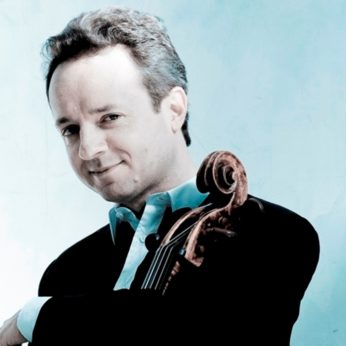Composer: Benjamin Britten (b. 1913 - d. 1976)
Performance date: 02/07/2013
Venue: Bantry Library
Composition Year: 1971/1974
Duration: 00:22:06
Recording Engineer: Damian Chennells, RTÉ lyric fm
Instrumentation: 2vn, va, vc
Instrumentation Category:Solo
Artists:
Marc Coppey -
[cello]

Britten intended the third of his three solo Cello Suites to be a tribute to his two close Russian friends, Rostropovich and Shostakovich. Shostakovich had introduced Rostropovich and Britten to each other in the early 1960s, and the cellist’s intense and technically masterful playing, as well as his lively personality, strongly influenced Britten who composed five works for cello during the next decade: a Sonata for cello and piano, the Symphony for Cello and Orchestra and three solo Suites (1964, 1967 and 1971, rev. 1974). The Third Cello Suite is often regarded as being the most approachable and, with its dark undercurrents, is the most deeply personal of the three.
Bach’s Suites for solo cello were a major influence on Britten although there are few obvious similarities, and, unlike Bach’s, each of Britten’s Suites has a different formal framework. In his Cello Suites Britten continues his experiments with textures built around a single melodic line that he had begun in the Church Parables. In their Cello Suites both composers have written works that create a strong emotional engagement and have a tremendous capacity for variation.
The nine contrasted short movements are played without a break, but the themes on which the work is based are not heard in their entirety until the last movement. Britten had previously used this ‘hidden variation’ technique in the Nocturnal after John Dowland and in the Lachrymae for viola and piano, and in the Cello Suite he combines it with the formal procedures that Shostakovich used in his later quartets, which Britten greatly admired. In the later works of both composers – works that are often highly charged, sometimes melancholy and introverted, sometimes defiantly rebellious – there is a clear emotional connection. Also, at the beginning of the first movement Britten uses Shostakovich’s well-known musical signature D-S-C-H (D-E flat-C-B). The melodic ideas are all Russian in origin; three folksongs that Britten knew from Tchaikovsky’s arrangements as songs with piano accompaniment and the traditional Russian hymn for the dead, Kontakion. In the fourth movement there is a lightly camouflaged glimpse of Bach himself. The chant-like solemnity of the opening Lento derives from the Kontakion, the tonally-disorientated Marcia is constructed from The Grey Eagle and Autumn, and the Canto from Under the Little Apple Tree. The full melody of Autumn is heard in the arpeggio figurations of Barcarola. The Fuga is linked to the Recitativo, which turns itself into the Moto perpetuo and both act as preludes to the Passacaglia. The Kontakion is used as the ground of thePassacaglia.
Copyright © 2024 West Cork Music. All rights reserved.
Designed and developed by Matrix Internet